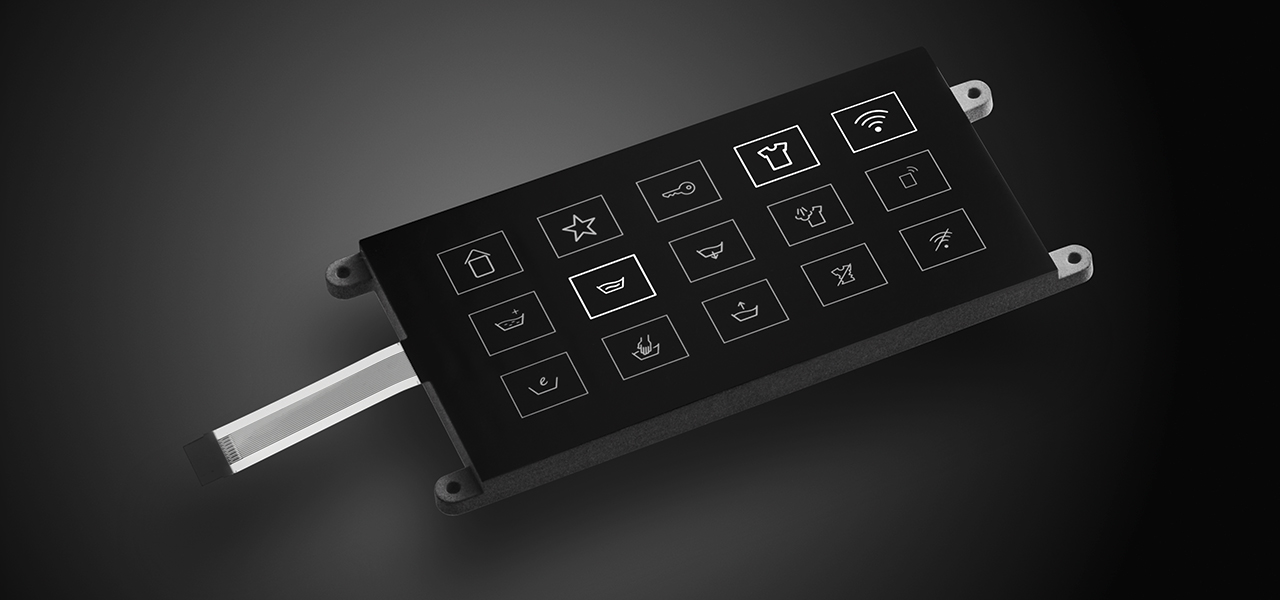
New Design Freedom thanks to Innovative Sensor Technology
Opaque decoration, individual design, and efficient production: The PolyTC® VarioSym sensor opens up new possibilities for touch control panels.
The Challenge
The digital world is constantly advancing, and smart homes are on the rise. Modern household appliances are becoming more and more convenient and smarter to meet the demands of the connected home. As technology evolves, so does the way we use washing machines, microwaves, and refrigerators. Smooth surfaces, invisible Shy -Tech elements (black panels), touch and gesture control, and highly individual designs determine how they look.
All of this presents manufacturers with new challenges. This is because they have to take into account aspects such as high transparency of the surfaces, color fastness, and backlighting right from the start. Hygiene is another important factor, especially in kitchens and bathrooms. Frequently touched surfaces must be easy to clean on a regular basis without damaging sensors or decoration.

The Goal
On the one hand, a PolyTC® VarioSym sensor should enable opaque decoration, but on the other hand, it should also be possible to create completely individual designs. For example, the customer should be able to flexibly choose the position of the touch buttons and have various symbols and functions displayed. The sensor should be used primarily for control panels and user interfaces in household appliances and consumer electronics.

The Solution
The new PolyTC® VarioSym sensor meets all of the above criteria. Integrated into a pioneering washing machine, it impressively illustrates what a modern control panel for household appliances can look like. PolyIC’s parent company, LEONHARD KURZ, demonstrated the technology live for the first time at the K plastics trade fair in Düsseldorf in 2022. Visitors were able to experience for themselves the high level of functionality, which is paired with maximum design freedom for capacitive keys, touch screens, and multi-touch sensors - even on curved and backlit surfaces. In addition, the high specification requirements in the area of 7-segment displays can be met and the assembly complexity reduced.
The major innovation is that the PolyTC® VarioSym no longer requires all components (touch sensor, diffuser, and opaque top layer) to be applied separately. The new sensor combines all relevant technical layers in one. In contrast to conventional manufacturing processes, this approach eliminates one component and one work step each, which enables more efficient, cost-saving production. Country languages and symbols are only lasered in the very last production step, so that the sensor can be used for a wide range of devices and national languages. The fact that this step is carried out by the customers themselves, directly before the sensor is installed, provides a completely new freedom when it comes to positioning symbols and labels.
In addition, the messy presentation of 7-segment displays due to the previously high lamination tolerances is no longer a problem either. Thanks to the final high-precision customization with lasers, the new sensor does not create any offset and therefore also no rejects.
Why PolyIC Is the Right Technology Partner

- PolyTC® sensors are made in Germany
- The PolyTC® sensors allow transparent or semi-transparent (radiolucent) touch applications
- Roll-to-roll manufacture facilitates the production of higher runs in consistently high quality
- Even small runs can be realized at the price advantage of large runs. Due to the end-of-line laser inscription, different variants for both small and large series only need to be customized directly prior to installation
- The KURZ Group, to which PolyIC belongs, is continually further developing its solutions
As a specialist for touch applications, our focus is on producing powerful sensor labels. The unique PolyTC® technology is a cornerstone of our global success. This procedure makes it possible to integrate very thin, flexible and transparent touch sensors into a wide variety of display applications. In addition to functionality, we attach great importance to design aspects. To this end, we use the synergies we share with parent company LEONHARD KURZ. Together with the decoration specialist, we create attractive designs with integrated touch technology for multi-sensory product experiences.
Conclusion
The PolyTC® VarioSym sensor is fully in line with the current and future trends in the design and operation of modern household appliances and consumer electronics. What’s more, the design also offers new possibilities for HMI systems in the automotive environment. In addition, it offers many economic advantages over conventional methods. It provides a high degree of customization, is suitable for a wide range of household appliances and consumer electronics, and ensures efficient production.
